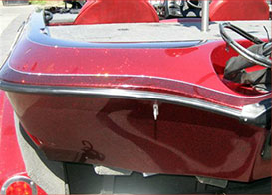 When a fiberglass boat isn’t cleaned and waxed regularly, it loses its shine and takes on a dull, chalky appearance. This is caused by the gelcoat oxidizing and suffering water damage. It doesn’t look very appealing, but the good news is that restoring the shine to a fiberglass boat and returning it to a dazzling finish is straightforward. Here are some tips for restoring a boat’s fiberglass finish.
When a fiberglass boat isn’t cleaned and waxed regularly, it loses its shine and takes on a dull, chalky appearance. This is caused by the gelcoat oxidizing and suffering water damage. It doesn’t look very appealing, but the good news is that restoring the shine to a fiberglass boat and returning it to a dazzling finish is straightforward. Here are some tips for restoring a boat’s fiberglass finish.
Fiberglass boats have a protective outer layer called gelcoat. The gelcoat plays no structural role in the construction of a boat, but it does form a protective barrier between the fiberglass and the elements, in particular UV rays and water. It also provides the glossy shine we love, and gelcoat is often pigmented to add rich color to a boat. Over time, exposure to harsh UV rays and moisture causes the gelcoat to oxidize, a chemical reaction that breaks down the surface. Oxidation leaves the gelcoat feeling rough to the touch, and gives it that slightly opaque, chalky look. When gelcoat oxidizes, it enables water to penetrate the surface. The water works into the compromised surface to form tiny pits, and eventually blisters and bubbles. The sooner you restore your fiberglass boat’s finish, the better, because oxidation and water damage get worse, and make the restoration process much more difficult.
Restoring Your Fiberglass Boats Finish
To restore shine to a fiberglass boat, it’s necessary to remove the oxidized portion of the gelcoat and return the outer surface to the glassy reflective finish it once had. It’s necessary to polish, or compound first and then polish the boat to restore the finish. Polish is a mild abrasive that gently removes the very topmost surface of the gelcoat that has oxidized. The polish removes the chalky discoloration and leaves the surface of the gelcoat mirror-flat once again. Compound is a slightly more abrasive version of polish and is used on gelcoat that has been neglected for a longer period and is heavily oxidized and pitted. After the oxidized gelcoat is compounded, it’s necessary to polish it to get that smooth glassy finish.
Marine Finish Protection: The next step after compounding and/or polishing off the oxidation is waxing. Boat wax provides a protective layer over the gelcoat that helps prevent further oxidation. If the boat isn’t waxed after it’s polished, the gelcoat will quickly oxidize again, and you’ll be forced to compound and/or polish it once more. Applying two or more coats of wax offers maximum protection to the gelcoat.
Boat Oxidation Prevention: Compounding and polishing a boat are time consuming and exhaustive processes. However, if you wax your boat regularly (at least twice a year or more if it’s exposed to extreme conditions), you may never need to polish or compound it again. Regular waxing preserves that reflective shine, which helps maximize your boat’s resale value should you ever decide to part with it.
Professional Marine-Grade Fiberglass Restoration Experts
With a passion for boats and a love for repairing and refurbishing them, Anchor Marine in the greater Minneapolis/St. Paul market specializes in the repair and refurbishment of fiberglass, aluminum surfaces. From boat painting to new floors and transoms, we can get your boat hull looking like it just rolled off the showroom floor, or better! To restore your fiberglass boat to its former glory, call the boat repair, renovation, and refurbishing experts at Anchor Marine Repair today at (763) 972-3540. Estimates, pickup, and delivery services are always free.

